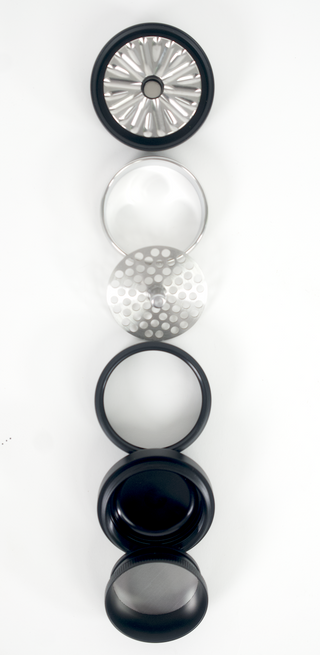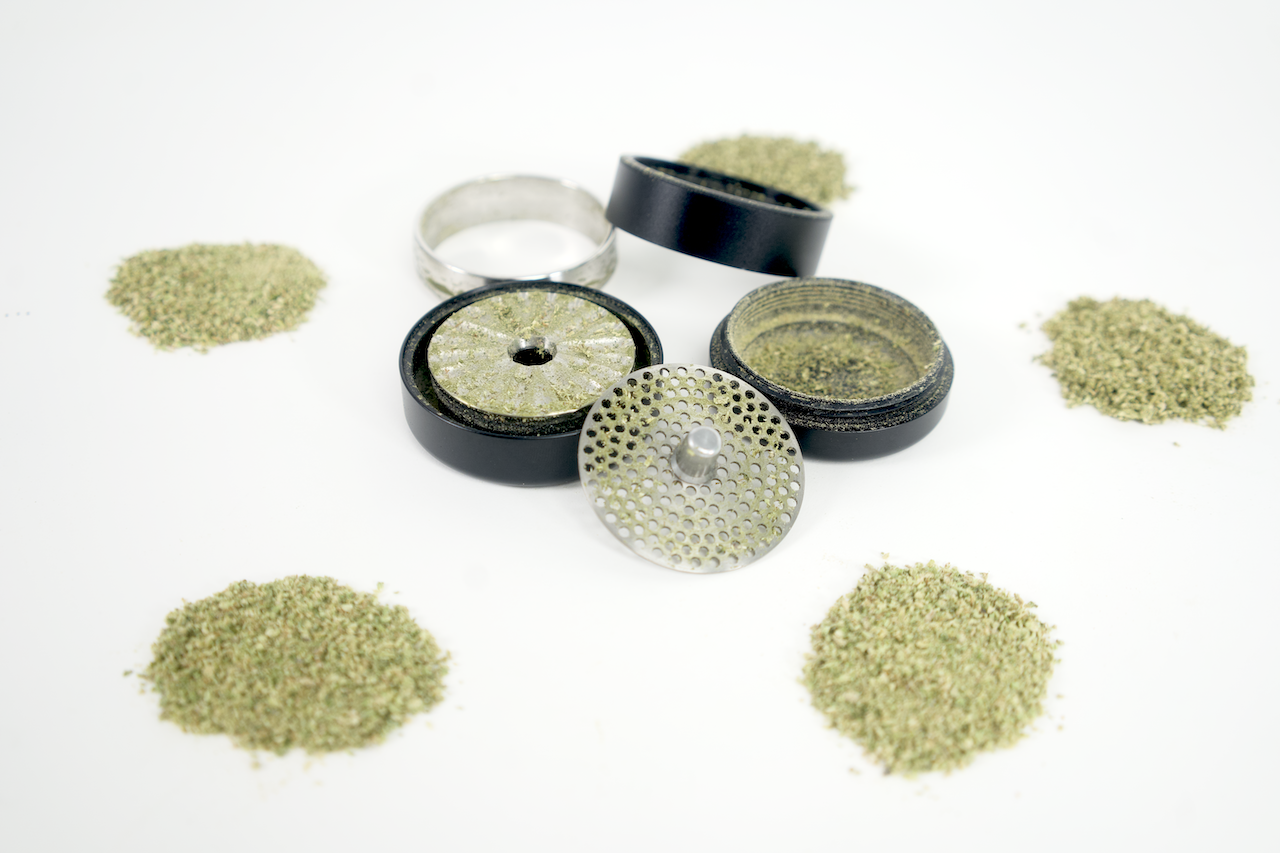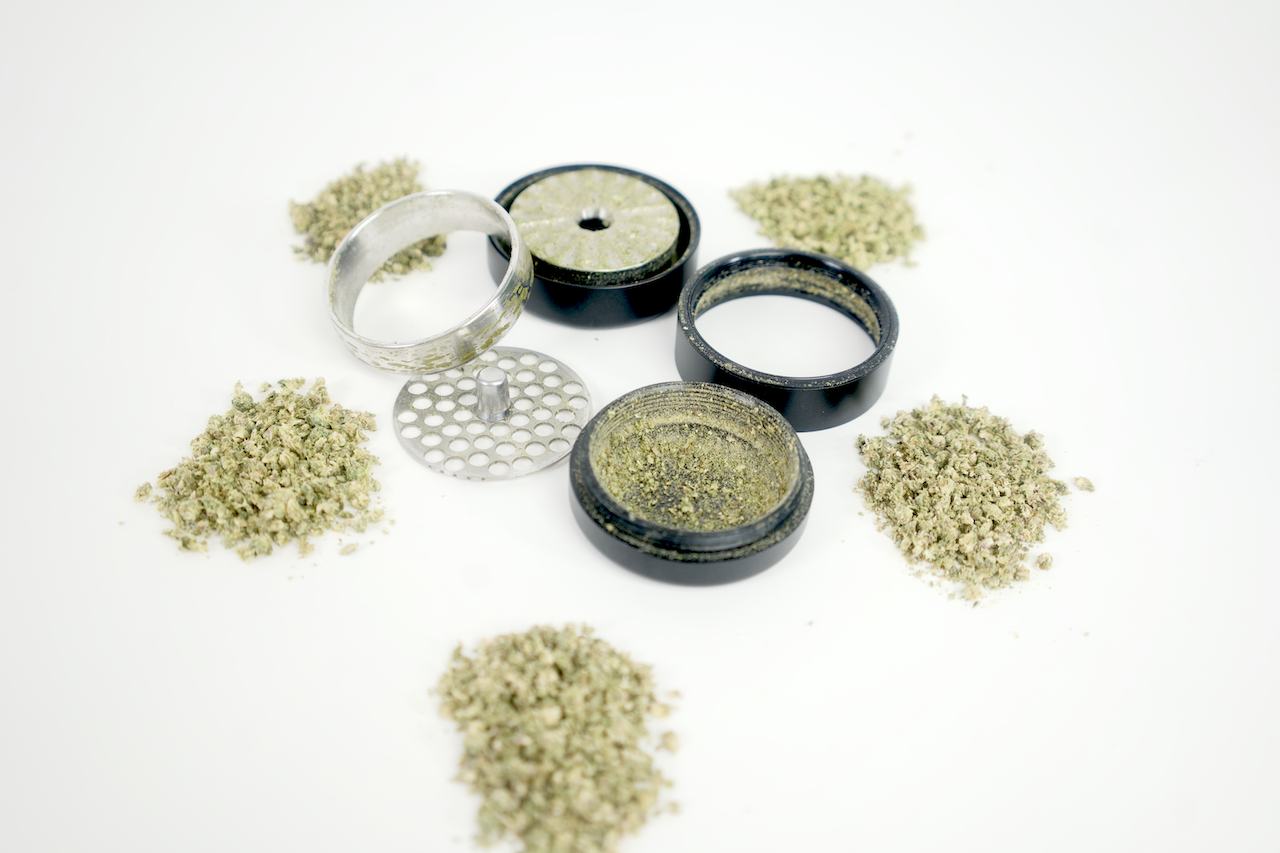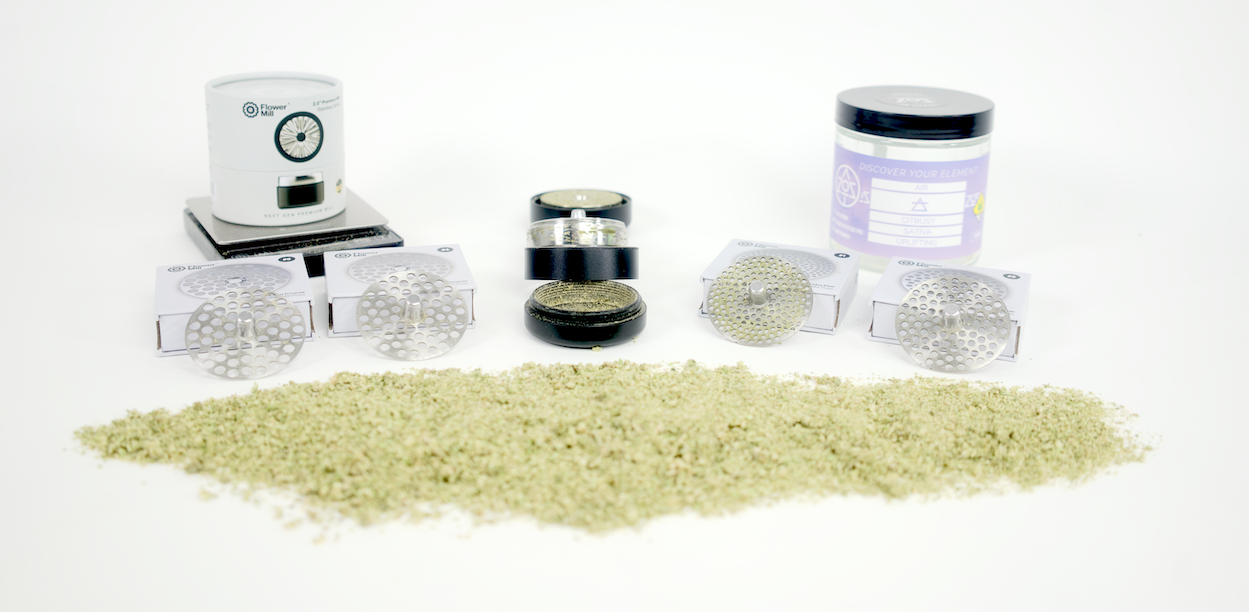Testing and Reviewing the Flower Mill Grinder
Posted by DaySavers Team on Jun 19th 2025
We recently put Cannabis Grinders Under the Spotlight, examining various grinding mechanisms, chamber functionalities, materials, the hottest features and stand out products leading the weed grinder category. But these days, one herb grinder in particular has the cannabis community talking: The Flower Mill. As they should be.
Traditional grinders, whether aluminum, plastic, or hemp, rely on sharp teeth to shred flower, which can pulverize the precious trichomes of the bud we’re preparing. Over time, new features were added. Modularity, for example, allows different chambers can connect to one another, allowing the user to adjust a 5-piece grinder to a 3-piece grinder. Magnets better connect chambers, threadless connections, adjustable particle screens and storage chambers.
But despite these improvements, shredding teeth have always been the standard.
But one group of engineers set out to revolutionize the cannabis grinder space and revolutionize they did. In 2017, Brent Stevens, a cannabis industry veteran, encountered a new grinding mechanism developed by Roiel Health and partnered with the team to develop and rebrand the device’s new milling mechanism for the cannabis industry.

Aptly named the Flower Mill, the patented new technology immediately rejuvenated the grinder category.
What is a Flower Mill?
Instead of shredding like a traditional toothed grinder, the Flower Mill uses a special fluted lid to push and roll the buds inside across a mill plate, like a food mill will do with your tomatoes. It produces a fluffier, well ground bud that is ready to load into your favorite pre-rolled cone or blunt, bong, bowl, vaporizer, whatever.
And due to the milling mechanism, stems are not shredded by the teeth and are often trapped in the particle screen, keeping the harsh, sharp shreds of stem in a separate chamber instead of with your perfectly ground flower.
After winning the Consumer Product of the Year award at the Emjays, put on by MJBizCon, the company set out to expand their line. Currently, their offerings include the 3-piece Next-Gen Standard aluminum series and the Next-Gen Premium series, available in high quality aluminum with a stainless-steel milling plate as well as the Next-Gen Premium Stainless series which includes an aluminum exterior and a food grade stainless steel milling chamber.
To become a household name in the cannabis industry is no easy feat, with thousands of cannabis producers and countless adjacent businesses, Flower Mill defied the odds, stormed onto the scene and is here to stay.
We set out to better understand the experience the Flower Mill offers by doing a full review and test of the grinding mechanism, running 1-ounce through the grinder in 28 1-gram batches using all 5 mill plates ranging from fine grind to extra course. Let’s see how the Flower Mill performs in grinding an ounce of sticky ZoZ bud. Here we go!

The Flower Mill “Grinder”
Originally dubbed the Crown grinder, the 3-piece First Gen Standard Edition Flower Mill was released in 2020, rolling herb across the particle screen with the fluted lit rotating above the bud, progressively crumbling the flower where it naturally wants to break apart.
The current Next-Gen Standard 3-piece Aluminum Flower Mill comes with a rotor lid, a particle screen chamber and the flower collector. The 7-piece Next-Gen Premium Series (yes, 7 pieces) comes in aluminum and stainless steel and has the same chambers as the 3-piece with the addition of removable mill plates, a ring that secures the mill plate in between the grinding chamber and the flower catcher, a threaded flower catcher, kief screen and kief catcher. Each series of grinder comes in two standard sizes, 2.5” and 2.0”.
The primary contrast between the Next-Gen Standard Flower Mill and the Next-Gen Premium are the differences in components and chambers as well as removable options. Mill plates can be adjusted between 5 different particle screens from a #1 fine grind to a #5 extra course grind, and the Next Gen comes with a kief screen that can be removed for a larger flower collection chamber. Your bud will also be more potent as the highly concentrated kief falls through the screen.
The Next-Gen standard comes in 5 vibrant colors while the Next Gen Premium comes in black, though recently released Next Gen Premium Housing components let you switch out the black stock housing for a customized look. Also offered is mill wax, a combination of hemp and beeswax that naturally reduces friction.
Operating the Flower Mill
Unlike grinders with sharp teeth, the Flower Mill milling chamber has room for flower to fit in the milling chamber prior to “grinding”, whereas with teeth grinders the flower simply sits on the lower teeth and is crushed and shredded between the top teeth, feeling unnatural and, frankly, outdated.
Using the Flower Mill is straightforward and only slightly different from standard teeth grinders. First, put your flower in the grinding chamber, breaking the bud down slightly and distributing the flower evenly within the chamber for best results and operation, making sure to avoid the center rod that goes up into the top rotor piece.
Next, place the rotor lid over the filling chamber and on top of the bud, in line with the center rod. Proceed to twist the rotor lid back and forth 180 degrees, applying very little downward force while keeping the rotor lid level. As the flower is milled, the rotor lid will lower as the flower inside crumbles. Once the lid has reached the milling plate, the feel and sound of the rotor making contact with the particle screen lets you know that your grind is complete.
Plus, since we’re milling flower instead of shredding it, seeds and stems stay intact, and the particle screen keeps them separated from your dank, fluffy flower that’s ready to toke.

Flower Mill Particle Screen Mill Plates
In true innovative fashion, the makers of Flower Mill incorporated interchangeable milling plates that offer varying ranges of particle sizes ranging from extra fine to extra course:
- Extra Fine - Ideal for dry herb vaporizers and one-hitters
- Fine - Perfect for packing cones and rolling joints
- Medium - Standard in all Flower Mills and versatile for any type of sesh
- Course - Great for pipes, bongs and blunts
- Extra Course - Perfect for blunts or large bowls
Varying particle sizes of cannabis are best suited for certain consumption based on multiple factors. Extra fine particles create a dusty pile of flower with more exposed surface area that make it solid for packing a one hitter or vaporizer. Fine particles are perfect for pre-rolled cones as the consistency makes for an even pack, helping the joint burn smoothly while avoiding canoeing from an uneven pack with hotspots throughout. Avoiding extra fine particles in pre-rolls will make for a better smoking experience as the fine cannabis particles can be easily compressed, restricting air flow.
A medium particle size is a great all around grind that serves many purposes due to a balance between airflow and burn rate. Course grinds are perfect for packing pipes and bongs because the larger particle sizes void clogging your piece from burnt pot pulling through your bowl. But the ultimate use-case for extra course pot particles: blunts. The large weed chunks allow for maximum airflow, avoid overpacking due to small particles, and promotes a smooth slow burn sought after by the blunt aficionado.

Reviewing and Testing the Flower Mill
When you get the opportunity to get your hands on a Flower Mill, the build quality will be felt right away. From the weight and finish to the smooth operation of the mill, it becomes clear why reviews and the reputation of Flower Mills are consistently positive. The absence of teeth allows for non-buds to remain separated from the milled flower, so the chances of janky, harsh stems and seeds infiltrating your freshly milled bud is much lower than when using sharp shredding teeth.
But to really understand what makes the Flower Mill a groundbreaking and adored product is to mill your own flower to experience the feel, function and quality of the milled bud. And that’s just what we did!
In the span of a day, we put the Next-Gen Premium 2.5” mill and all 5 mill plates to the test, grinding a full ounce (28g) in 1-gram batches, focusing on grind time, torque and resistance, consistency of particle size, total yield and resin build up.
The process included:
- A single individual operating the mill for consistent data collection, a test manager recording and timing the experiment, and a photographer to document the process;
- Weighing out 28 1-gram batches of premium sticky, Washington-grown ZoZ Mimosa bud using a precision scale, weighing the bud post-milling as well;
- Testing the performance of each mill plate, with plates 1, 2, 4 and 5 running through 5 batches while the standard #3 plate ran 8 batches;
- Weighing the initial weight of the Flower Mill as well as the weight after every batch to judge how much kief or resin it collected;
- Grading the torque needed and jams or resistance encountered during the experiment as well as particle consistency; and
- Finally, smoke a big ol’ glass tipped DaySavers pre-rolled tube using the fresh ground bud the Flower Mill prepared.
Putting the Flower Mill to the Test
To assure accurate weights of the milled flower, we opted to remove the kief screen so we could better assess the final weight yielded after milling. We also had trouble separating the kief screen from the chamber ring it is attached to, so we removed them both, which doesn’t affect the threads when opening and closing the mill. Before each mill plate was put to the test, we weighed the Flower Mill with the new plate to get an accurate starting weight due to the varying weights of the mill plates that have varying sizes of particle holes, causing variances in weight.
Outside of quantitative data like weights and time, we rated from 1-5 the torque required, jams and resistance, and grind consistency from, with 1 representing low effort regarding torque and jams and a low consistency among milled particle sizes.
With an ounce of bud in hand, a brand new Flower Mill, each milling plate, and an eager bunch of DaySavers in search of the best grinders around, we began milling!
Let’s recap:
- Next-Gen Premium 2.5” Stainless Steel Series Flower Mill tested
- ZoZ Mimosa Cannabis used, last 7 batches using ZoZ Candy Pave
- 28 total test batches, each 1-gram with grind time clocked for each batch
- Mill screens #1, #2, #4 and #5 tested 5 times, screen #3 tested 8 times
- Kief screen and adjoined collection ring removed for test
- Grinder and flower (1g) weighed before and after milling, being re-weighed after each mill plate swap
- Torque required and Resistance encountered were measured on a scale from 1-5, with 1 being a resistance free and low torque milling
- Grind consistency is also measured on a 1-5 with 5 being a uniform particle consistency and 1 being uneven
- The initial and final weight of the Flower Mill contains the #3 mill plate
- Order of mill plates used during testing: #3, #2, #4, #1 and #5
- Operator reviewed all official Flower Mill guides before running the test
- As advised by the operation tips, flower was not broken apart as long as it fit into the milling chamber

#1 Extra-Fine Mill Plate

Reviewing the Flower Mill Test Results
There is a reason the cannabis community accepted the Flower Mill so enthusiastically, it performs, looks and feels great, and the flower you’ve milled is noticeably fluffier. After using a sharp teeth grinder for the better part of 15 years, I can definitively say that my preference far leans towards milling my bud with the flower mill over the classic, standard, “stock” teeth grinder.
With an average grind time of 4.5 seconds, the interaction between the mill plates, flower, rotor, and milling chamber creates an efficient and effective mechanism for grinding flower. With the absence of sharp teeth on both sides of the milling chamber pieces, flower is very easy to load, compared to a teeth grinder where the bud gets sandwiched between two pieces that are far from being attached to each other.
One key operational tip was used consistently throughout, level rotations of the rotor lid with low pressure were applied during each milling batch.
#2 Fine Mill Plate

Weights and Yield
After 28-grams of ripe, sticky bud was run through the mill, the kief and resin build up added 0.7-grams to the weight of the Flower Mill which started at 282.9-grams, a 2.5% loss in total cannabis weight. But build up, especially within an herb grinder, is expected as cannabis is naturally sticky due to the terpene- and cannabinoid-rich trichomes atop the buds. Pair that with compression and friction and you’re sure to see build-up.
Interestingly enough, the average yield of ground flower per batch was 0.96 grams while the range sat at 0.7-grams to 1.2-grams, suggesting that ground flower particles and flecks of compact build-up can stick during one milling, and fall into the flower catcher during another, varying the yield sporadically throughout.
With course mill plates featuring larger particle holes than the fine screens, the data met expectations. The larger mill plates, #4 and #5, averaged an even yield of 1-gram, showing that larger particle holes pass through more milled flower than finer plates. Plates #1, #2, and #3 consistently averaged a 0.9-gram yield, affirming that finer particle screens either hold back more flower from falling through or that the small size of the particle holes increases the chances of buildup on the walls, rotor lid, and mill plate.
And while the data shows plate #3 in the same circle as the fine plates, the ease of grind and visible build up was much lighter on plate #3, followed by #2, and concluding with the extra-fine #1 mill plate. In fact, the #1 plate showed visible green build up, and while still producing a yield of 0.9-grams, the signs of left-behind cannabis is greater as the particle holes shrink.
To note, a few seeds and a handful of stems were caught by the particle screens throughout which affected the final yield.
Overall, Flower Mill weight gain for mill plates #1, #2 and #3 averaged 0.26 grams while the course plates, #4 and #5, only gained an average of 0.1-grams, showing that larger particle holes lead to more bud in your ground flower chamber.
When it comes to mill vs classic teeth grinders, the Flower Mill encounters less lock up of the threads and rotating pieces from compressed kief and resin, which means less cleaning and frustration when your trusty grinder locks you out. The Flower Mill also avoids the buildup of flower on sharp teeth which can make it harder to grind and retrieve your ground bud, meaning less time tending to your device.
#3 Medium Mill Plate

Time to Mill 1-Gram of Flower
With an average milling time per batch of 4.46 seconds, only mill screen #1 comes in over the average; 63% longer in fact, averaging 7.25 seconds. This too is to be expected, as size and disparity of holes in larger grinders means particles find their way through the holes much quicker and easier than the finest plate.
Interestingly enough, both the #2 and #4 plates averaged a mill time of 3.25 seconds, while the 8-round medium #3 plate came in a second at 4.25 seconds. While we expected a consistent drop in time from smaller to larger particle holes, the human factor comes into play. Getting in a rhythm throughout the first round of batches was a factor of note, finding a consistent cadence while working to keep the rotor lid as even as possible.
The extra-course #5 plate also produced surprising results, coming in at a 4.5 second average time to mill, the second highest of the 5 plates. As noted in the introduction to this experiment, plates #1 and #5 were the last two mill plates tested, respectively. Entering the test at batch number #19 and #24, more than 60% of the test bud had been run through the mill, contributing to build up, resistance, and required torque.
Taking this into account, the 0.8 second gap between the average of plate #4’s and the average of plates #1-3’s seems less wide, while the 3.4 second gap between the first 3 plates average and plate #1 clearly show that the extra-fine particle screen requires more milling time than its wider counterparts.
#4 Course Mill Plate

Ground Flower Consistency
Flower is an extremely influential factor when considering the consistency of ground flower in any grinder. Sticky bud will put your grinder through more effort than dry flower that is brittle and can easily transform into a fine powder with little pressure or friction. For this reason, we connected with our pals at ZoZ, producers of top-shelf buds and good times, running through 28-grams of their Mimosa sativa and hybrid Candy Pave.
The consistency of the milled flower through 28 batches scored a 4.04, which ranks very well logically and even better when you refer to the data. Large particle holes in mill plates allow flower to fall through much easier than an extra-fine plate due to the sheer size of the particle holes, while fine and extra-fine plates require the milled cannabis be of a certain size before falling into the herb catcher.
The data supports this across the board, with a perfect 5 for mill plate #1 while mill plate #5 scored a 2.8, followed by #4 at 3, #3 at 4.25, and #2 at 5. And this is to be expected, cannabis buds come in a wide range of water activity levels and moisture content. Try running a brittle dry nug through any grinder with a large particle screen and see if you’ll get anything more than a coarse powder.
Plates #4 and #5 did produce larger particle sizes, but there was also a lot of smaller particles in the mix. To expect uniform extra-course particle size throughout your milled flower, stickier buds are required. In this experiment we worked with sticky bud and still noticed a discrepancy in particle size, so while stickier buds keep from turning into a fine powder all together, shards and pieces of flower that are smaller than your particle screen will occur. This is surely true for all milling screens but is far more pronounced with larger mill screens that let a wide range of particle sizes fall, while finer screens retain flower in the milling chamber until the bud has broken down enough to fit through the fine particle holes.
Grind consistency was perfect for plates #1 and #2, with plate #3 close behind, producing even particle sizes consistently with holes large enough that fine particles fall through, earning steady scores of 4 compared to the perfect scores earned by the fine plate options.
It should be noted that while plates #4 and #5 scored far lower on milling consistency than their smaller counterparts, the overall consistency properly corresponds to the plate names. Coarse plates will produce thicker particle sizes, they’ll just be accompanied by some or a bundle of smaller particle sizes depending on the moisture content, stickiness, and the cleanliness of your mill.
#5 Extra-Course Mill Plate

Required Torque and Resistance Met
Finally, we looked at more operational variables that affect the process of breaking down flower using a grinder or mill, resistance, jams and resistance. Friction and pressure when milling or grinding weed will cause kief and resin build-up from the sticky substance continually coming in contact with more flower receiving pressure and friction between two surfaces with one rotating. This is an especially common occurrence with sharp teeth grinders as they pulverize the trichomes and have many surfaces where buildup can occur.
Did the Flower Mill experience build up? Of course, just like your fingers get sticky and gunky when you breakdown your flower by hand. Sticky bud is a gift and a curse. On one hand you have dank fire, on the other you have a sticky situation, and if that is a so-called curse, we’ll take it.
While particle hole size is surely a factor in resistance caused by build-up and the torque required to operate the mill, extended use is likely the biggest factor on torque and resistance. Looking at our test from start to finish, mill screen #3, the first mill plate in our test, scored the lowest in both torque (1.38) and resistance (1.25), and fitting for a brand new Flower Mill right out of the box.
The next two mill plates up, #2 and #4, both scored 1.8 for torque and a 1.6 and 1.8 for resistance, respectively. Plate #1, the second to last mill plate to be tested, scored highest in both torque (2.4) and resistance (2.6). This too makes perfect sense. After 19 grams of sticky bud ran through the mill and with the finest particle size now in place, it should be expected that the previous build up, paired with the time required to mill particles down to the fine particle hole sizes, will cause build up, create resistance, and require more torque.
With an average torque score of 1.86 and a resistance score of 1.79, it’s clear that even after an ounce of sticky icky, the Flower Mill is able to mitigate extreme build up that is more likely to occur with sharp teeth grinders. Like any grinder, there comes a time to break out the isopropyl alcohol and give your device a nice soak and cleaning, but take solace in the fact that with a Flower Mill, that build up takes longer to affect functionality, leaving you more time to breakdown bud, pack up a pre-roll, and smoke a doobie with your buds.
Flower Mill Test Data Set
| Batch + | Mill Plate | Flower Mill Pre-Mill Weight (g) | Torque Required (1-5) | Resistance Met (1-5) | Time to Mill (s) | Milled Flower Yield (g) | Grind Consistently | Flower Mill Post-Mill Weight (g) |
|---|---|---|---|---|---|---|---|---|
| 1 | Plate #3 | 282.9 | 1 | 1 | 3.06 | 0.9 | 5 | 282.9 |
| 2 | #3 | 282.9 | 1 | 1 | 4.25 | 0.9 | 4 | 282.9 |
| 3 | #3 | 282.9 | 1 | 1 | 4.94 | 1 | 4 | 283.1 |
| 4 | #3 | 283.1 | 1 | 2 | 4.43 | 1 | 5 | 283.1 |
| 5 | #3 | 283.1 | 2 | 2 | 5.51 | 1 | 4 | 283.2 |
| 6 | #3 | 283.2 | 2 | 1 | 5.83 | 0.7 | 4 | 283.3 |
| 7 | #3 | 283.3 | 2 | 1 | 3.16 | 1.2 | 4 | 283.1 |
| 8 | #3 | 283.1 | 2 | 1 | 2.88 | 1 | 4 | 283.2 |
| 9 | Plate #2 | 283.7 | 1 | 1 | 3.15 | 1 | 5 | 283.7 |
| 10 | #2 | 283.7 | 2 | 1 | 3.76 | 0.9 | 5 | 283.8 |
| 11 | #2 | 283.8 | 2 | 2 | 3.26 | 0.9 | 5 | 283.7 |
| 12 | #2 | 283.7 | 2 | 2 | 3.45 | 0.8 | 5 | 283.9 |
| 13 | #2 | 283.9 | 2 | 2 | 2.61 | 0.9 | 5 | 284.0 |
| 14 | Plate #4 | 282.2 | 1 | 2 | 2.52 | 0.9 | 3 | 282.4 |
| 15 | #4 | 282.4 | 2 | 2 | 2.75 | 1.1 | 3 | 282.4 |
| 16 | #4 | 282.4 | 1 | 2 | 2.86 | 0.9 | 4 | 282.5 |
| 17 | #4 | 282.5 | 2 | 2 | 3.69 | 1.2 | 2 | 282.4 |
| 18 | #4 | 282.4 | 3 | 2 | 4.43 | 1.2 | 3 | 282.5 |
| 19 | Plate #1 | 284.1 | 2 | 2 | 5.69 | 1 | 5 | 284.3 |
| 20 | #1 | 284.3 | 2 | 2 | 7.08 | 1.1 | 5 | 284.4 |
| 21 | #1 | 284.4 | 2 | 3 | 5.20 | 0.8 | 5 | 284.6 |
| 22 | #1 | 284.6 | 3 | 3 | 8.98 | 0.8 | 5 | 284.4 |
| 23 | #1 | 284.4 | 3 | 3 | 8.78 | 0.8 | 5 | 284.5 |
| 24 | Plate #5 | 282.2 | 3 | 3 | 4.10 | 1 | 4 | 282.1 |
| 25 | #5 | 282.1 | 2 | 2 | 4.78 | 1 | 3 | 282.3 |
| 26 | #5 | 282.3 | 2 | 1 | 4.36 | 1 | 3 | 282.4 |
| 27 | #5 | 282.4 | 2 | 2 | 4.61 | 0.9 | 3 | 282.4 |
| 28 | #5 | 282.4 | 2 | 2 | 4.73 | 1.1 | 2 | 282.2 |
Observations Encountered During Flower Mill Test
Throughout the experiment, we recorded key events that arose:
- Batch 6 – Plate #3 Batch 6: Buildup beginning to form on the milling side of the rotor lid and exterior of the stainless steel housing
- Batch 10 – Plate #2 Batch 2: Milled flower chamber threads becoming sticky and difficult to open and close
- Batch 14 – Plate #4 Batch 1: Severe difficulty opening milled flower chamber, build up on threads progressing
- Batch 15 – Plate #4 Batch 2: Mill flower chamber threads would need to be cleaned at this point to properly open and close
- Batch 20 – Plate #1 Batch 2: Milled flower chamber no longer able to open, have reverted to removing mill plates to access milled flower
- Batch 22 – Plate #1 Batch 4: ZoZ Mimosa bud ran out, transitioned to ZoZ Candy Pave flower during final batches
- Batch 24 – Plate #5 Batch 1: A noticeable amount of plant matter stuck to the rotor lid loosened and fell through the particle holes
- Batch 27 – Plate #5 Batch 4: Bud particles are starting to stick to the walls and bottom of the milled flower chamber due to kief build up

DaySavers Flower Mill Assessment
As cannabis enthusiasts ourselves, grinders play a big part in our daily lives, and the most common feedback we hear is that resin build up happens quickly and locked up grinders are extremely frustrating. With innovation happening throughout the industry, from glass tipped infused blunts to solventless concentrates, the world of grinders was prime for disruption, and the Flower Mill did just that.
The cannabis industry welcomed the Flower Mill with open arms back in 2020 and we fully support that sentiment. The innovation around the grinding mechanism is a breath of fresh air as the milling construction allows for pre-ground flower to sit inside the herb mill instead of sitting between to sharp toothed pieces. The smooth rotation of the rotor lid requires very little pressure to produce fluffy milled bud, and the time it takes to achieve this milling is short and sweet.
Once you feel the rotor lid meet the mill plate, your batch has been milled, and if you feel any remaining particle in-between your mill plates, it’s most likely a stem that wasn’t milled down into your fluffy flower pile, a major bonus especially for those packing pre-rolls where shards of stems can easily puncture paper or wraps. While torque required and resistance met build over time, we’re working with herb that is innately sticky and expectations of build-up need to be understood.
Also, clean your Flower Mill from time to time and that won’t happen.
Milled flower consistency was very positive, and while larger particle holes produced a less even consistency, we expect this to happen with any grinder using large particle holes as the smaller particles created from grinding will surely accompany the larger particles into the final milled flower.

In the end, we determined that the Flower Mill grinder:
- Produced extra-fluffy ground flower
- Mill plate #2 is ideal for packing pre-rolled cones while plate #4 and #5 are best for pre-rolled blunts
- Mill plate #2 produces the ideal particle size for use in the Perfect Pack Machine
- Separated stems and seeds from ground flower
- Recorded very low milling times per batch
- Avoided major grinder blockers such as resistance met and torque required to rotate the rotor lid
- Grind consistency is even and produces a quality yield, especially among finer particle sizes
- Was easy to use and maintained a favorable milling experience throughout
- Only the milled flower chamber threads were affected by kief and resin build up
Establishing a successful brand in the crowded cannabis industry can be an uphill battle, which is why the success of the Flower Mill is case study worth understanding. The brand innovated in the grinder space after years of more stagnation among these products with a revolutionary patent to mill flower instead of shred it. Yes there have been innovations over the years like electric, modular, and threadless grinders, but the grinding mechanisms have stayed nearly the same, employing teeth or blades to shred flower.
Flower Mill did more than add features to an existing product, they blazed a trail toward innovation with the development of a grinder that had never hit the market. The industry noticed, consumers noticed, and so did the pre-roll crew at DaySavers.
What set up do we use for packin’ pre-rolls? Why, the 2.5” Next-Gen Premium Stainless Series with the #2 fine mill screen of course, perfect for both hand packing and Perfect Packing.
When you’re ready for an upgrade, we recommend the Flower Mill for all your cannabis preparation needs.
Aptly named the Flower Mill, the patented new technology immediately rejuvenated the grinder category.









